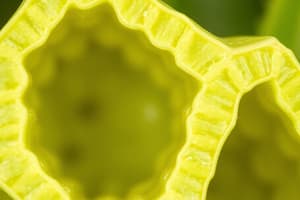Podcast
Questions and Answers
What is the major component of the cell wall?
What is the major component of the cell wall?
Cellulose
What is the substance between plant cells?
What is the substance between plant cells?
Middle lamellae
What forms the primary cell wall?
What forms the primary cell wall?
Cellulose microfibrils, pectin, hemicellulose, soluble proteins
How does the protein extensin benefit the cell?
How does the protein extensin benefit the cell?
What are the functions of the cell wall?
What are the functions of the cell wall?
In what ways can a plant cell expand?
In what ways can a plant cell expand?
In what ways does the cell wall protect a plant?
In what ways does the cell wall protect a plant?
How does the secondary cell wall differ from the primary cell wall?
How does the secondary cell wall differ from the primary cell wall?
What properties does lignin provide?
What properties does lignin provide?
How does the plant cell work around the water-blocking properties of the secondary cell wall?
How does the plant cell work around the water-blocking properties of the secondary cell wall?
What are plasmodesmata?
What are plasmodesmata?
What is a potential disadvantage of plasmodesmata?
What is a potential disadvantage of plasmodesmata?
What are the two phases of the cell wall?
What are the two phases of the cell wall?
Flashcards are hidden until you start studying
Study Notes
Plant Cell Walls Overview
- Major component of plant cell walls is cellulose, providing structural support.
- Middle lamellae serve as a substance between adjacent plant cells, facilitating adhesion.
Structure of the Cell Wall
- Primary cell wall consists of cellulose microfibrils, pectin, hemicellulose, and soluble proteins, contributing to flexibility and strength.
- Secondary cell walls are thicker, formed after cell growth and contain lignin, which adds durability and rigidity.
Functions of the Cell Wall
- Provides overall structure and shapes plant cells, influencing morphology.
- Protects against pathogens and prevents excessive water uptake, enhancing cell survival.
Expansion and Growth
- Plant cells can expand uniformly in all directions or preferentially along a specific axis, increasing cell length.
Protective Mechanism
- Rigidity of the cell wall acts as a barrier against physical damage and biological threats.
- Infected cells can secrete protective chemicals via cell walls to mitigate neighboring infection spread.
Lignin and Its Role
- Lignin contributes strength and rigidity to the secondary cell wall and creates a hydrophobic barrier to water, limiting fluid intake.
Water Movement
- Plasmodesmata are microscopic channels between plant cells allowing for the passage of water-soluble substances, bypassing the hydrophobic nature of secondary walls.
Communication and Vulnerability
- Plasmodesmata's continuous plasma membrane and extending endoplasmic reticulum enable rapid molecular exchange.
- Viruses exploit plasmodesmata to spread between plant cells, posing a risk to overall plant health.
Cell Wall Composition
- The cell wall consists of two primary phases: crystalline microfibrillar phase and a non-crystalline matrix, combined with extensin networks for structural integrity.
Studying That Suits You
Use AI to generate personalized quizzes and flashcards to suit your learning preferences.



